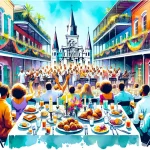Located on the shores of Lake Pontchartrain, Milneburg was once a flourishing port town and popular resort destination that played a pivotal role in shaping New Orleans’ storied history and distinctive cultural identity.
In This Article
TL;DR
- Milneburg was a bustling port and summer resort area in the late 19th and early 20th centuries, drawing visitors from New Orleans and beyond.
- Jazz music thrived in Milneburg’s dance halls and clubs, with influential musicians and bands performing in the town, aiding the genre’s spread.
- The town’s diverse blend of African American, European, and Native American influences shaped its distinctive character and legacy, contributing to New Orleans‘ traditions and heritage.
Milneburg’s Early History
Milneburg’s roots trace back to the early 19th century, when it was a small fishing village on the shores of Lake Pontchartrain. The town was named after Alexander Milne, a Scottish businessman who acquired the land in 1831 and developed it into a port and transportation hub.
As Milneburg grew, it became a significant center of commerce and trade for New Orleans. The Pontchartrain Railroad, completed in 1831, connected the town to the city, facilitating the movement of goods and passengers between the two locations. This transportation link, along with the construction of a lighthouse and pier, helped establish Milneburg as a key player in the economic and social life of New Orleans throughout the 19th century.
Rise as a Resort Destination
In addition to its role as a port town, Milneburg also gained popularity as a summer retreat for New Orleans residents seeking respite from the city’s intense heat and humidity. The town’s lakefront location offered cool breezes and opportunities for swimming, fishing, and other recreational activities.
Attractions such as bathhouses, amusement parks, and dance halls drew visitors from across the region, contributing to the local economy and shaping Milneburg’s reputation as a lively and entertaining destination. The Washington Hotel and the Bali Hai restaurant were among the most popular establishments, offering dining, dancing, and live music.
Jazz and Music Scene
Milneburg played a crucial role in the development and popularization of jazz music in the late 19th and early 20th centuries. The town’s dance halls and clubs provided a platform for African American musicians to showcase their talents and experiment with new styles and techniques.
Influential jazz pioneers such as Buddy Bolden, Louis Armstrong, Sidney Bechet, and Danny Barker performed in Milneburg’s venues, helping to establish the town as a hotbed of musical innovation. The lively atmosphere and diverse crowds at these establishments created an environment where jazz could flourish and evolve, eventually spreading to other parts of New Orleans and beyond.
Cultural Diversity and Traditions
Milneburg’s location at the intersection of various cultures and communities contributed to its unique identity and traditions. The town’s population included African Americans, Europeans (particularly Germans), and Native Americans, each bringing their own customs and influences to the mix.
This cultural blend gave rise to distinctive festivals, celebrations, and culinary traditions that reflected Milneburg’s diverse heritage. Events such as the Milneburg Mardi Gras and the Blessing of the Fleet showcased the town’s vibrant spirit and sense of community.
Milneburg’s Decline and Legacy
Despite its prosperity and cultural significance, Milneburg began to decline in the mid-20th century due to a combination of factors, including changing transportation patterns, urban development, and the rise of new entertainment districts in New Orleans.
As the town’s population and economic activity dwindled, many of its historic buildings and landmarks fell into disrepair or were demolished. However, efforts have been made in recent years to preserve and commemorate Milneburg’s legacy, recognizing its important contributions to New Orleans’ history and culture.
Milneburg Today
Today, the former site of Milneburg is largely occupied by the University of New Orleans and the Lake Oaks subdivision. While little remains of the original town, its spirit lives on through ongoing initiatives to celebrate and interpret its legacy.
The Milneburg Lighthouse, built in 1832 and now located on the University of New Orleans campus, stands as a tangible reminder of the town’s maritime heritage. The lighthouse is open to the public for tours on select days, offering visitors a glimpse into Milneburg’s past.
The Milneburg Mardi Gras, held annually on the Saturday before Mardi Gras, pays homage to the town’s festive traditions with a parade, live music, and food vendors. The event takes place at the Lake Pontchartrain Basin Maritime Museum in Madisonville, Louisiana, about a 45-minute drive from New Orleans.
Address: 133 Mabel Drive, Madisonville, LA 70447
Hours: 10:00 AM – 4:00 PM on the Saturday before Mardi Gras
Admission: Free
For those interested in exploring Milneburg’s musical legacy, the New Orleans Jazz Museum offers exhibits and educational programs that highlight the town’s role in the development of jazz.
Address: 400 Esplanade Ave, New Orleans, LA 70116
Hours: Tuesday – Sunday, 10:00 AM – 4:30 PM
Admission: $8 for adults, $6 for seniors and students, free for children under 12
By engaging with these events and institutions, visitors and residents alike can gain a deeper appreciation for Milneburg’s rich history and enduring influence on New Orleans’ cultural landscape.






